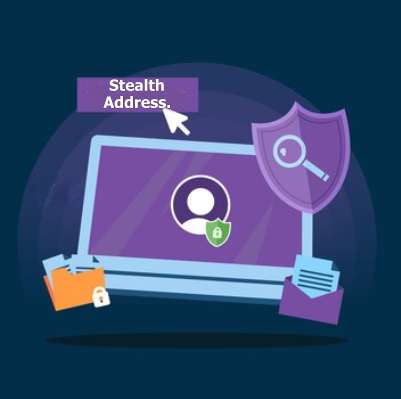What Are Stealth Addresses? How Do They Work? Benefits and Limitations
If you’re engaging in crypto transactions with the hope of remaining untraceable, you might be disappointed to learn that everything is, in fact, traceable.
While it may seem challenging, individuals with a deep understanding of cryptography can eventually decipher how to track addresses, given that sending and receiving addresses along with transaction details are publicly available.
This renders cryptocurrencies pseudonymous, revealing enough information for traceability.
Fortunately, several solutions exist to enhance privacy, such as transaction mixers and layer 2 lightning transactions.
A recent addition to this list is the stealth address.
What Is a Stealth Address?
True to its name, a stealth address is a one-time address utilized to receive crypto assets.
The concept of stealth addresses was initially introduced by Peter Todd and Gregory Maxwell in 2014 as part of the Bitcoin Improvement Proposal (BIP) 63.
While initially proposed for Bitcoin, stealth addresses have garnered attention in various privacy-focused cryptocurrencies like Monero, Bytecoin, and Ethereum.
How Does Stealth Address Work?
The concept of stealth addresses is employed in various ways across the crypto blockchain, but the general principle involves deriving stealth addresses from the recipient’s public key and a randomly generated data segment known as a “scan key.” This approach ensures that stealth addresses can be shared publicly without compromising the recipient’s privacy or exposing their main address.
To be specific, the stealth address works in the below fashion.
First, the recipient generates a pair of keys: a public “spend” key and a private “view” key. The spend key is used for sending transactions, while the view key is used to monitor incoming transactions and generate stealth addresses.
Simultaneously, the sender generates a random “scan key” for each transaction they want to initiate.
Next, the sender combines the recipient’s public spend key and the scan key to derive a unique, one-time stealth address using a deterministic algorithm.
Finally, the sender broadcasts the transaction to the blockchain network, specifying the stealth address as the recipient’s address.
The recipient actively monitors the blockchain for incoming transactions by scanning for stealth addresses derived from their view key and the sender’s scan key. Upon matching a stealth address, the recipient can access the funds using their private spend key.
Benefits Of Stealth Address.
Unlinkable Transaction.
The utilization of stealth addresses makes tracing transactions and identifying the individuals involved considerably challenging.
With each transaction directed to a unique stealth address, the likelihood of address reuse diminishes, significantly complicating efforts to link multiple transactions to a single recipient
Enhanced Privacy.
Stealth addresses effectively conceal the recipient’s main address from both the sender and the public blockchain, rendering it exceedingly difficult to trace the individual behind the transaction.
Compatibility with Existing Infrastructure.
Stealth addresses can seamlessly integrate into existing cryptocurrency networks without necessitating substantial alterations to the underlying protocol or consensus mechanisms.
Drawbacks Of Stealth Address.
Volume.
Frequent transactions using stealth addresses can pose challenges in linking, reconciling, redeeming, and managing transactions, as each transaction is associated with a unique address.
Potential for Denial of Service (DoS) Attacks.
An attacker generating a large number of stealth addresses could overwhelm the recipient’s resources, potentially leading to a Denial of Service (DoS) attack.
Increased Computational Overhead.
Generating and verifying stealth addresses necessitates additional computational resources, which can impact the overall efficiency and scalability of the cryptocurrency network.
Privacy Trade-Off.
While stealth addresses enhance privacy, they do not guarantee perfect anonymity.
Transaction details, such as product/service types and quantities, could still be revealed when aggregated, potentially exposing transacting parties’ behavior and identity.
Adoption and Implication Challenge.
Achieving widespread adoption and implementation of stealth addresses requires coordination among cryptocurrency developers, exchanges, and wallet providers. This process can be complex and time-consuming.
These represent some of the benefits and drawbacks of stealth addresses.
Earlier in the post, mentioned that there is no specific path to use a stealth address. So here next, we’re looking at how some crypto assets implement the stealth address on their blockchain.
How Monero Utilizes Stealth Addresses.
Monero employs multiple privacy-enhancing mechanisms, including ring transactions, stealth addresses, and RingCT (Confidential Transaction), to obscure your address and confuse potential trackers.
For stealth addresses, Monero utilizes the public key of the sender’s wallet. This generated Stealth Address serves as the transaction receiver address on the blockchain. Utilizing elliptic curve mathematics, Monero creates a Stealth Address from public keys encoded in the recipient wallet address, incorporating a large randomized factor.
Ring Confidential Transactions (RingCT) enable transactions to blend funds from other senders without revealing the amount of the funds. Additionally, ring signatures ensure that transactions are validated without disclosing the amounts involved.
How Ethereum Utilizes Stealth Addresses.
Stealth Addresses were first proposed in the ERC 5564 standard, which establishes the framework for generating and interacting with stealth addresses on the Ethereum platform.
Ethereum employs the same stealth address mechanism as outlined in the standard operational procedure for stealth addresses.
Recipients initiate the creation of a meta-address, which comprises two pairs of keys: one for spending (controlling funds) and one for viewing.
This meta-address is then shared with the sender, who undergoes a computational process to generate a stealth address belonging to the recipient.
The recipient must safeguard the corresponding private keys of the spending and viewing keyset, as they can be utilized to identify and manage a stealth address.
Conclusion.
Stealth Addresses represent a significant advancement in the realm of cryptocurrency, particularly in enhancing privacy and anonymity.
By assigning a unique, one-time address for each transaction, stealth addresses obscure the connection between the sender and recipient, thereby increasing the complexity of tracing transactions and uncovering financial activities.
As the demand for privacy and security continues to escalate, stealth addresses are poised to achieve broader adoption and play a pivotal role in shaping the future of privacy-focused cryptocurrencies.
